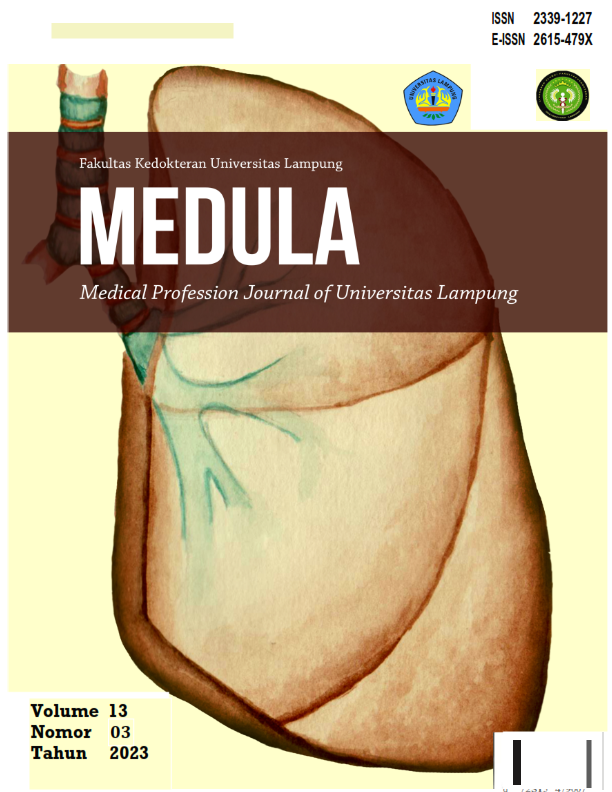Etiology, Pathophysiology, Evaluation, and Management of Drug Induced Hepatotoxicity
DOI:
https://doi.org/10.53089/medula.v13i3.636Abstract
Drug induced liver injury (DILI) is an acute or chronic liver injury caused by drugs or herbal compounds that have been known for more than 1000 drugs and herbal compounds to cause hepatotoxicity classified based on the clinical picture of the mechanism of hepatotoxicity, or the histological picture of the liver biopsy. The annual incidence of DILI in the general population is below 15-20 per 100,000 population. DILI has 2 pathogenesis mechanisms, namely intrinsic, which is dose dependent, and idiosyncratic, which is more unpredictable. DILI is thought to be related to a combination of hospitalization, medications, and environmental factors. Host factors are patient age, sex, genetic polymorphism, immune status, and metabolism. Drug factors include dose, duration, weight, and level of lipophilicity. Environmental factors consist of alcohol use, diet, tobacco, and poisons. Abnormal patterns of liver tests can differentiate between types of liver injury. In hepatocellular injury, there is a marked increase in transaminases (usually 3 times the upper limit) compared to ALP levels. In cholestatic or cholestatic injuries, ALP is usually 3 times the upper limit of normal compared with transaminases. There is also a mixed injury pattern in which both aminotransferases and ALP are 3 times the upper limit of normal.
References
Loho IM, Hasan I. Drug-Induced Liver Injury – Tantangan dalam Diagnosis. CDK. 2014; 41(3) :167-70
Fisher K, Vuppalanchi R, Saxena R. Drug-Induced Liver Injury. Arch Pathol Lab Med. 2015 Jul;139(7):876-87. Tersedia dari:https://pubmed.ncbi.nlm.nih.gov/26125428
Chalasani N, Bonkovsky HL, Fontana R, Lee W, Stolz A, Talwalkar J, et al. United States Drug Induced Liver Injury Network. Features and Outcomes of 899 Patients With Drug-Induced Liver Injury: The DILIN Prospective Study. Gastroenterology. 2015 Jun;148(7):1340-52.e7. [PMC free article: PMC4446235] Tersedia dari: https://pubmed.ncbi.nlm.nih.gov/25754159
Tujios SR, Lee WM. Acute liver failure induced by idiosyncratic reaction to drugs: Challenges in diagnosis and therapy. Liver Int. 2018 Jan;38(1):6-14. [PMC free article: PMC5741491] Tersedia dari: https://pubmed.ncbi.nlm.nih.gov/28771932
Fontana RJ. Pathogenesis of idiosyncratic drug-induced liver injury and clinical perspectives. Gastroenterology. 2014 Apr;146(4):914-28. [PMC free article: PMC4031195] Tersedia dari: https://pubmed.ncbi.nlm.nih.gov/24389305
Katarey D, Verma S. Drug-induced liver injury. Clin Med (Lond). 2016 Dec;16(Suppl 6):s104-s109. [PMC free article: PMC6329561] Tersedia dari: https://pubmed.ncbi.nlm.nih.gov/27956449
Kuna L, Bozic I, Kizivat T, Bojanic K, Mrso M, Kralj E, Smolic R, et al. Models of Drug Induced Liver Injury (DILI) - Current Issues and Future Perspectives. Curr Drug Metab. 2018;19(10):830-838. [PMC free article: PMC6174638] Tersedia dari: https://pubmed.ncbi.nlm.nih.gov/29788883
Chalasani NP, Hayashi PH, Bonkovsky HL, Navarro VJ, Lee WM, Fontana RJ. Practice Parameters Committee of the American College of Gastroenterology. ACG Clinical Guideline: the diagnosis and management of idiosyncratic drug-induced liver injury. Am J Gastroenterol. 2014 Jul;109(7):950-66; quiz 967. Tersedia dari: https://pubmed.ncbi.nlm.nih.gov/24935270
Navarro VJ, Khan I, Björnsson E, Seeff LB, Serrano J, Hoofnagle JH. Liver injury from herbal and dietary supplements. Hepatology. 2017 Jan;65(1):363-373. [PMC free article: PMC5502701] Tersedia dari: https://pubmed.ncbi.nlm.nih.gov/27677775
Teschke R, Danan G. Molecular Research on Drug Induced Liver Injury. Int J Mol Sci. 2018 Jan 11;19(1) [PMC free article: PMC5796165] Tersedia dari: https://pubmed.ncbi.nlm.nih.gov/29324638
Kleiner DE, Chalasani NP, Lee WM, Fontana RJ, Bonkovsky HL, Watkins PB, et al. Drug-Induced Liver Injury Network (DILIN). Hepatic histological findings in suspected drug-induced liver injury: systematic evaluation and clinical associations. Hepatology. 2014 Feb;59(2):661-70. [PMC free article: PMC3946736] Tersedia dari: https://pubmed.ncbi.nlm.nih.gov/24037963
Robles-Díaz M, Medina-Caliz I, Stephens C, Andrade RJ, Lucena MI. Biomarkers in DILI: One More Step Forward. Front Pharmacol. 2016;7:267. [PMC free article: PMC4992729] Tersedia dari: https://pubmed.ncbi.nlm.nih.gov/27597831
Ahmad J, Reddy KR, Tillmann HL, Hayashi PH, Chalasani N, Fontana RJ, et al. Importance of Hepatitis C Virus RNA Testing in Patients with Suspected Drug-Induced Liver Injury. Dig Dis Sci. 2019 Sep;64(9):2645-2652. [PMC free article: PMC6706305] Tersedia dari: https://pubmed.ncbi.nlm.nih.gov/30927209
Suk KT, Kim DJ. Drug-induced liver injury: present and future. Clin Mol Hepatol. 2012 Sep;18(3):249-57. [PMC free article: PMC3467427] Tersedia dari: https://pubmed.ncbi.nlm.nih.gov/23091804
Kleiner DE, Chalasani NP, Lee WM, Fontana RJ, Bonkovsky HL, Watkins PB, et al. Drug-Induced Liver Injury Network (DILIN). Hepatic histological findings in suspected drug-induced liver injury: systematic evaluation and clinical associations. Hepatology. 2014 Feb;59(2):661-70. [PMC free article: PMC3946736] Tersedia dari: https://pubmed.ncbi.nlm.nih.gov/24037963
Real M, Barnhill MS, Higley C, Rosenberg J, Lewis JH. Drug-Induced Liver Injury: Highlights of the Recent Literature. Drug Saf. 2019 Mar;42(3):365-387. Tersedia dari:https://pubmed.ncbi.nlm.nih.gov/30343418
Teschke R. Idiosyncratic DILI: Analysis of 46,266 Cases Assessed for Causality by RUCAM and Published From 2014 to Early 2019. Front Pharmacol. 2019;10:730. Tersedia dari: [PMC free article: Tersedia dari: PMC6664244] https://pubmed.ncbi.nlm.nih.gov/31396080
Downloads
Published
How to Cite
Issue
Section
License
Copyright (c) 2023 Medical Profession Journal of Lampung

This work is licensed under a Creative Commons Attribution-ShareAlike 4.0 International License.














